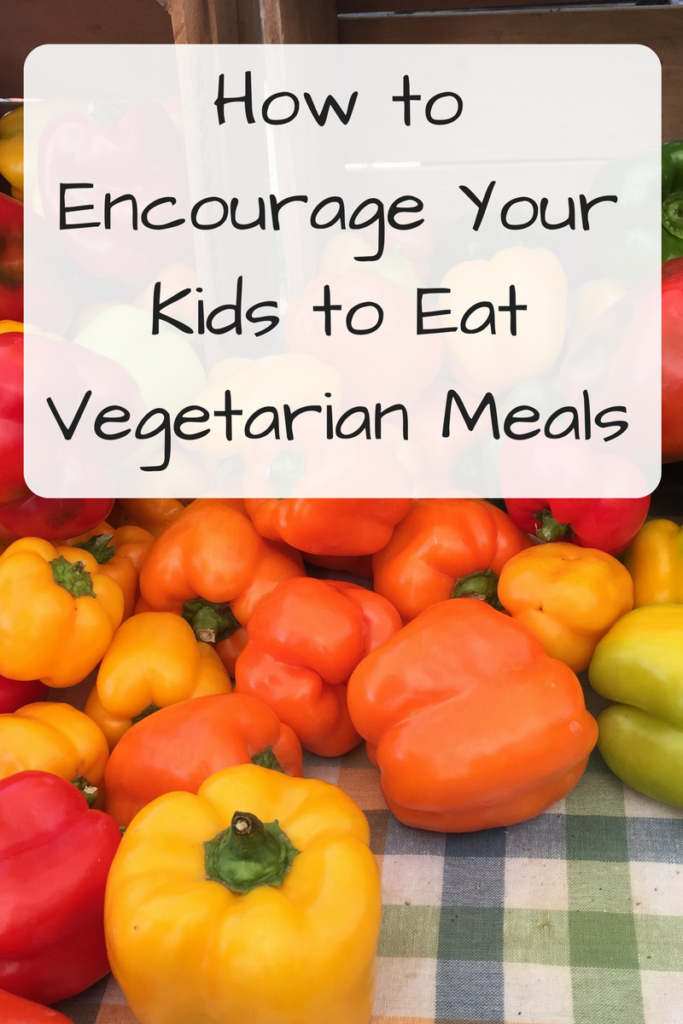Want to eat vegetarian meals more often in your family but not sure how to introduce your kids to it? Check out these 9 tips!

“Come on, try a broccoli tree,” I say, my voice taking on the edge of a whine. My three-year-old pokes at his broccoli with a finger. Most of the time in this situation, he tries at least one. For a preschooler, that’s not too bad. While I love the health benefits of eating your vegetables, I also want to eat vegetarian more often for the sake of the environment.
Agriculture contributes to nine percent of the greenhouse gas emissions in the U.S. that cause climate change, with meat and dairy production making up a large percentage of that. In addition, many livestock farms also have negative impacts on the air and water in their local areas. Fortunately, you don’t need to go full-on vegetarian or vegan to make a difference. Not eating meat once a week – such as meatless Monday – can reduce your carbon footprint.
Since many kids are resistant to trying anything new, here are some ways we’ve found to eat vegetarian food and make it more appetizing.
Make vegetarian food fun to eat
Kids love interacting with their food. My son loves shelling edamame, snap beans, and English peas. Most kids love dipping things, making hummus and baba ganoush a hit. (Although if your kid is anything like mine, you’ll want to give them their own portion or end up watching in horror as they lick the cracker and then stick it back in the dip.) While there are lots of Pinteresty ideas for making fruits and veggies fun, I don’t think it needs to be that complicated. On the other hand, if you’re good with a knife and crafty, more power to you!
Try diverse protein sources
One of people’s biggest fears of a vegetarian diet is not getting enough protein, especially for kids. Their second biggest fear may be eating tofu.
Thankfully, there are a lot of other options for non-meat proteins. For example, my three-year-old is surprisingly fond of chickpeas, black beans and pinto beans. Beans are great in a variety of dishes, have a lot of flavor, and are relatively cheap. There’s a reason rice and beans are staples in many cultures! Nuts and seeds are also great protein sources, from walnuts in oatmeal to sunflower butter on a sandwich. On the slightly more exotic side, seitan offers a nice chewy texture and hearty flavoring.
Eat foods from different cultures
Americans eat an enormous amount of meat and dairy, but many other cultures don’t. In particular, Indian and Thai food has many vegetarian dishes that don’t require any substitutions. Coconut milk, chickpeas, vegetables, raisins and curry powder can make for an amazing vegan meal. (This curry recipe looks delicious!) The book How to Cook Everything Vegetarian by Mark Bittman is wonderful at both offering a variety of dishes and a lot of different variations on them.
Think beyond the meat and potatoes paradigm
As someone who both worked in fine dining and grew up in a traditional household in terms of food, my husband loves the “main dish at the center of the plate with sides” structure of meals. Unfortunately, that structure doesn’t lend itself well to a lot of vegetarian foods.
Instead, a love of stews, soups, curries, and casseroles will go a long way. This set of recipes from Parents Magazine looks delicious and features a number of variations on the traditional plating.
While it isn’t fully vegetarian, using meat as a flavoring instead of a main dish is also a good way to minimize how much of it you eat. The book Simply in Season provides a lot of great seasonal recipes that take this approach.
Appreciate vegetarian meals for what they are
Way too often vegetarian and vegan writing says, “It’s just like cheese!” or “It’s just like meat!” Ha, no. Anyone who says soy cheese is just like Wisconsin cheddar probably hasn’t eaten good cheese in decades. Fortunately, vegetarian dishes don’t have to be like meat – they’re perfectly delicious on their own. Play up the inherent deliciousness of the dishes without comparing them to something else.
Have the kids participate in growing and shopping
The best way to have kids eat their vegetables is for them to participate in picking them out! Even if you don’t grow your own, you can have them join in at the farmers’ market or grocery store.
Model enthusiasm
Kids won’t want to try new foods unless you do. Being genuinely interested and enthusiastic about new foods can be contagious.
For other tips on eating sustainably, check out Why I Love Our CSA (Community Supported Agriculture) Farm Box. If you’re interested in pursuing a more sustainable lifestyle with your family, join our Green and Sustainable Parenting group on Facebook!